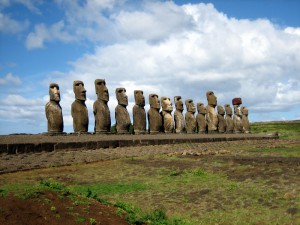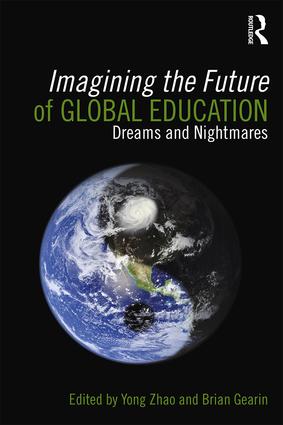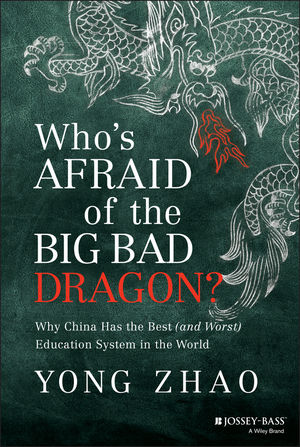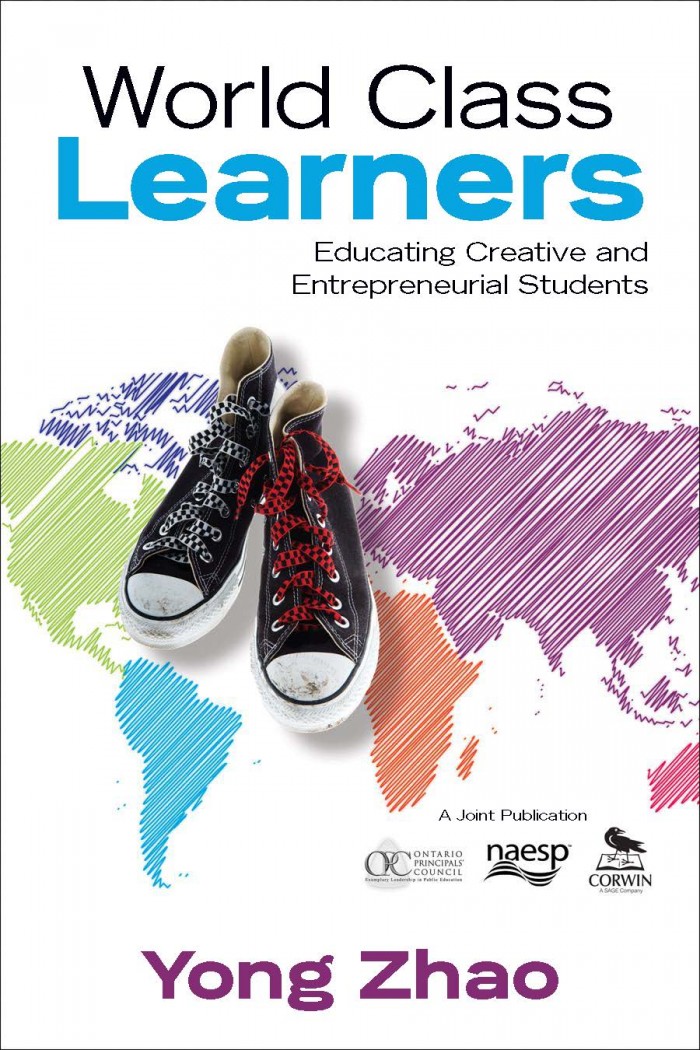Race to Self Destruction: A History Lesson for Education Reformers
 Race to the Top, Obama Administration’s $4.35 billion education initiative, has been touted many times by the President and his Secretary of Education Arne Duncan as “the most meaningful education reform in a generation”. It is also been proposed as the blueprint for the upcoming reauthorization of the Elementary and Secondary Education Act (ESEA), currently bearing the more notorious title No Child Left Behind (NCLB). I have always found Race to the Top amusingly sad and educationally harmful and written about it in different places including an op-ed piece in Education Week and a couple of posts on my blog. Today when I was re-reading Jared Diamond’s brilliant book Collapse: How Societies Choose to Fail or Succeed, I found his story of how the Easter Islanders’ race to build the most magnificent statues eventually led to their collapse chillingly similar to what is happening to American education.
Race to the Top, Obama Administration’s $4.35 billion education initiative, has been touted many times by the President and his Secretary of Education Arne Duncan as “the most meaningful education reform in a generation”. It is also been proposed as the blueprint for the upcoming reauthorization of the Elementary and Secondary Education Act (ESEA), currently bearing the more notorious title No Child Left Behind (NCLB). I have always found Race to the Top amusingly sad and educationally harmful and written about it in different places including an op-ed piece in Education Week and a couple of posts on my blog. Today when I was re-reading Jared Diamond’s brilliant book Collapse: How Societies Choose to Fail or Succeed, I found his story of how the Easter Islanders’ race to build the most magnificent statues eventually led to their collapse chillingly similar to what is happening to American education.
The hundreds of stone statues on Easter Island have been one of the greatest mysteries on earth. Located in the southern Pacific Ocean, Easter Island is over 2,000 miles away from the closest land, Chile, and 1,400 miles away from the nearest island, which is uninhabited. It is also a very small island, only 15 miles long and 10 miles wide. Yet, on this remote and small island are over 800 giant statues carved out of stone. They are large and heavy—ranging from 15 feet to 70 feet and from 10 to 270 tons. The largest ever erected weighed over 80 tons. Some of them have a separate headpiece, a cylinder of red scoria that weigh up to 12 tons. When the first European explorer discovered it in 1722, the island was almost uninhabited, with just a few thousand people living in poor conditions without any advanced technology. The explorers did not find any large animals or trees that could be used to help move and lift the statues.
How could the islanders have carved, transported, and erected the statues because “organizing the carving, transport, and erection of the statues required a complex populous society living in an environment rich enough to support it” (Diamond, 2005, p.81) and such a society was apparently nonexistent when Easter Island was discovered?
Many theories have been proposed. “Many Europeans were incredulous that Polynesians, ‘mere savages,” could have created the statues or the beautifully constructed stone platforms” (Diamond, 2005, p. 82). They attributed these grand works to other civilizations and even intelligent space aliens. But Jared Diamond, a professor of Geography and Physiology of UCLA and a Pulitzer Prize winner for his book Guns, Germs, and Steel, presents a more compelling theory. Equipped with a large cumulative body of knowledge generated by archaeologists, historians, anthropologists, and other scientists, Diamond uncovers a history of tragic self-destruction on Easter Island.
The giant statues were indeed created by the Polynesians who began to occupy Easter Island about 1,000 years ago, when it was covered with forests of big and tall trees, some of which reached to about 100 feet in height and seven feet in diameter. These trees could be used to make seafaring canoes that enabled more productive fishing. Easter Island provided habitats for many species of seabirds. Coupled with a rather sophisticated agriculture, Easter Islanders developed a civilization that once had an estimated population of 15,000. Such a population provided sufficient labor force to carve, transport, and raise the statues. The tall trees provided the necessary tools and materials to transport and raise the statues.
The giant statues were also one of the primary causes of the collapse of the Easter Island civilization. The island was divided into about a dozen territories and each belonged to one clan. Diamond suggests the statues were raised to represent their ancestors and there was a competition going on between rival clans. Each chief was trying to outdo their rivals by erecting larger and taller statues, and later adding the heavy headpiece on the statues. The statues became a symbol of status, power, and prestige to impress and intimidate rivals. And because of Easter Island’s particular situation, building bigger statues became virtually the only race among the clans. As a result, the statues got bigger, taller, and fancier.
The race was costly. It took tremendous resources to carve, transport, and erect these statues. It needed surplus food to feed the people working on the statues and thus required more farming land. Trees were cut down to build vehicles for transporting and supporting the erection. Ropes used to pull the statues were made from barks of the tall trees. As more, bigger, and taller statues were built, more trees were cut down. Slowly, the whole forest on Easter Island disappeared, so were all tree species. “Immediate consequences for the islanders were losses of raw materials, losses of wild-caught foods, and decreased crop yields…The further consequences start with starvation, a population crash, and a descent into cannibalism” (Diamond, 2005, p.107, 109) Eventually, the Easter Island civilization collapsed, leaving hundreds of broken, fallen, and unfinished stone statues littered on a barren island.
Although there are competing theories pointing out that human activities may not be the only cause of deforestation and ecosystem collapse on Easter Island (e.g., some scientists suggest rats as another contributing factor), Diamond provides a convincing “example of a society that destroyed itself by overexploiting its resources.” A significant driving force behind the overexploitation was the race to erect bigger statues.
I can’t help making the connection between Easter Islanders’ race to erect the statues and Obama’s Race to the Top initiative and proposed plan for reauthorization of NCLB, which has already set American education on a race of test scores for a decade. Some may object to this metaphorical connection by arguing that test scores represent the quality of education a school provides, the performance of a teacher, and students’ ability to succeed in the future. But the chiefs and priests on Easter Island also believed that the statues represented the health and power of their clans, the performance of their members, and promise for a more prosperous future.
Test scores have no doubt become American’s stone statue in education. America wants to outscore other countries on international tests such as PISA and TIMSS, just like the Easter Island’s rival clans wanted to out build each other. NCLB and Race to the Top force states, schools, and teachers to outscore each other with either a club or carrots or both. Whether it is the complex AYP calculation formula or the proposed even more complex value-added-measures, the ultimate measure remains scores on standardized tests. Whether it is the prescribed punitive measures of NCLB or the proposed “reward for excellence” by Obama, the criteria are the same: test scores and the intention no different: outscore others.
In their race to build bigger statues, Easter Islanders put increasingly more resources into carving, transporting, and erecting statues. Likewise, in America’s race to obtain higher test scores, American schools have invested more resources in raising test scores. A large proportion of schools have spent significantly more time on the tested subjects (math and reading) and reduced time for other subjects and activities. Teachers have spent more time preparing students for standardized tests and focused more time on tested content. Millions of hours are spent each year for students to take the standardized tests. Billions of dollars are spent each year on testing or simply measuring whose statue is larger.
Just like the Easter Islanders’ obsession with building statues damaged their ecosystem, America’s obsession with test scores have already begun and will continue to damage its education ecosystem. The high stakes attached to test scores have already forced states, schools, and teachers to improve test scores at any cost—manipulating standards, cheating, teaching to the tests, and only focusing on those students who can bring the most gains in scores. Students who are talented and interested in things that do not contribute to improving scores are considered at risk and put in special sessions to improve their scores. Teachers’ professional autonomy is taken away so they can more easily forced to raise test scores. Local democratically elected school boards are rendered assistants of the federal government to raise test scores. American’s traditional educational strengths—tolerance of diversity, respect for individual difference, and celebration for creativity—are replaced with standardization so as to raise test scores. A broad and balanced curriculum is narrowed to what can be easily scripted and measured so as to raise test scores.
What is more dangerous is that the Easter Islanders perhaps did not realize their imminent collapse before it was too late. Blinded by the short-term glory of their magnificent statues, they were preoccupied with creating even more magnificent ones while the last palm tree was cut down. Equally blinded by the potential of common standards and testing programs to improve test scores, the current administration is ignoring the real civil rights issues facing our children: poverty, unsafe neighborhoods, and unequal access to educational resources. Basking in the victorious sunshine of forcing some 40 states to change laws and policies and trade their constitutional rights to education for promised federal dollars, the Obama Administration may be getting closer to cut down the last palm tree in American education land.
And ultimately, just like Easter Island ended up a barren island filled with big statues, America may succeed in raising test scores but it will likely end up as a nation of great test takers in an intellectually barren land.
Actually, this has happened before. China’s imperial testing system, keju, enticed generations of Chinese to study for the test so as to earn a position in government and bring glory to the family. But it has been blamed as a cause of China’s failure to develop modern science, technology, and enterprises as well as China’s repeated failures in wars with foreign powers because good test takers are just that: good at taking tests and nothing else. Until today, China is still working hard to move away from a test-oriented education in order to have the talents to build a knowledge-based economy (See Chapter 4 of my book Catching Up or Leading the Way).
Update:
Dr. Doug Green has an excellent summary of the myths and negative consequences of standardized testing based on a book on his site: http://drdouggreeen.com.
Also, an AP story about President Obama’s recent speech seems to suggest that the President does not really like testing either but is this just talk in front teachers and students or will he eliminate standardized testing in the new ESA?
References:
Diamond, J. (2005). Collapse: How Societies Choose to Fail or Succeed. New York: Penguin.




























[…] Race to Self Destruction: A History Lesson for Education Reformers is by Yong Zhao. […]
[…] Race to Self Destruction: A History Lesson for Education Reformers is by Yong Zhao. I’m adding it to The Best Posts On How To Prepare For Standardized Tests (And Why They’re Bad). addthis_url = 'http%3A%2F%2Flarryferlazzo.edublogs.org%2F2011%2F03%2F28%2Ftwo-good-school-reform-posts%2F'; addthis_title = 'Today%26%238217%3Bs+Collection+Of+Good+School+Reform+Posts'; addthis_pub = ''; […]
Wise connection. Mayans did the same with their drive to paint the temples with lime plaster.
The battle is on to make our children extinct. Here’s how:
We now have public schools fighting private who are fighting choice or chance. When we finally understand that we are all in the same boat and the whole system is broken, we can move toward the systemic change that is needed to help students truly learn, as well as help teachers take back their profession.
When NCLB put a strong emphasis on the artificial standardized test several major changes were made that did damage to the system of education. First, schools began, or continued to rank students based on a singular means of assessment. What a surprise as we are now learning that when someone is ranked first, mathematically someone must be ranked last. The first go to college while the last are pushed out of school and into a subclass for the rest of their lives. With this knowledge it becomes evident that schools help to create the class system and the problem becomes, who will we push out of school? Thus the Easter Island class war.
Secondly, with the emphasis on the test, teachers have been forced to abandon their professions and teach to the test. Educating young people and teaching to the test are two different things. Educating means learning for the future. Teaching to the test is about winning, getting the highest test score possible by any means possible. The result of the latter is “book learned” students without a lick of common sense.
The solution to the problem requires an overhaul of the education system that is not for the faint of heart. It takes children from where they are and they don’t have to fight or beat anything. However, if you don’t want to give the same speeches fifteen years from now, the effort for systemic change must go forward. My book, “Saving Students From Shattered System” has the details including the dominoes that will fall as well as the building blocks to replace them. If we continue the same path we will continue to fail. It is mathematically impossible to educate all children under the current system, just pit them against each other.
What we are doing to kids is not just unethical, it is immoral. The time is now to advocate for this change. Contact us at http://www.WholeChildReform.com and pass the word to all you know. The time for systemic reform is now!
Cap Lee
Milwaukee
I am interested in whether the segment highlighting ‘America’s traditional educational strengths: tolerance of diversity, respect for individual difference and celebration of creativity’ is a summary from Yong Zhao or whether this is taken from an official statement. If these are the strengths, (I’d say values) perhaps a simple reassessment of how powerful and laudable these values actually are would help the debate. Laurie, Nanjing
We have lost our context, our awareness and understanding of history. And so, we are perhaps destined to “achieve” collapse. The world’s emphasis on “progress” seems to be leading toward and even grander collapse.
I did not know you left MSU, but am glad you found a new home. This is Garth from Ohio meet with you several time with Ed. I was impressed by your ability to draw the connection with Jared Diamond’s work. Loved Guns, Germs, and Steel.
I believe the push to end unions (Ohio passed SB5 and governor signed it today) and more standardized testing is an attempt to end public education as we know it. I see this as an attempt to find ways for more “Choice”. How will this play out? I am unsure, but district will not be able to raise the money needed to keep up as the state turns the fund more and more to the local taxpayer who in turn will then attach the school use of the funds. In the end, it all falls. As was noted above, we need structural reform. Who will lead that?
Garth wrote: “I was impressed by your ability to draw the connection with Jared Diamond’s work.”
That is what true intellectual ability is. Contrasting, comparing, synthesizing information. Let’s develop that in all students! The principles of Bloom’s taxonomy were part of my daughters Gifted And Talented Education pull-out time when she was in elementary school, but it should be part of all students’ everyday curriculum!
http://www.officeport.com/edu/blooms.htm
Thank you for this…I really like it. Impressive thinkers like you are wonderful examples of what is really at stake. Many thanks for wanting to fight this tedious and long-lasting battle.
Annie
Kudos to Professor Zhao for a brilliant metaphor – Easter Island and Race to the Top. And the connection to the Chinese Imperial exams. The writing, as they say, is on the wall.
As a Chicago Public Schools teacher, I can vouch for the damage being done to our children on a daily basis due to the misguided policies of people like Arne Duncan.
It gives me hope to read this blog by Professor Zhao. As a teacher working in the trenches, it is important to keep my perspective in this time of irrational corporate education reform.
It is up to teachers to work toward stopping the “tyranny of testing”, a phrase recently uttered by our very own Chicago interim-CEO Terry Mazany. It seems that HE gets it. Too bad Rahm Emanuel won’t be appointing him the CEO of our schools.
Thanks for your erudite observations. Join us in the March on Washington in July to make our voices heard. “Save our Schools March and National Call to Action” http://www.saveourschoolsmarch.org/event_info/the-march/
Wonderful synthesis.
I don’t think the test scores are exactly what the American establishment is after. Their agenda is to defund a growing non-Caucasian voting American citizenry, and to make a private profit while doing so. The race for test scores is just part of their rationale, as it is an easy sell to a large swathe of Americans.
We must never lose sight of the legacy of the late Paul Weyrich of the
Heritage Foundation and the American Legislative Exchange Council.
Weyrich helped Eric Heubeck pen a radical-right manifesto in 2001.
Excerpts:
“This essay is based on the belief that the truth of an idea is not
the primary reason for its acceptance. Far more important is the
energy and dedication of the idea’s promoters—in other words, the
individuals composing a social or political movement…”
“There will be three main stages in the unfolding of this movement.
The first stage will be devoted to the development of a highly
motivated elite able to coordinate future activities. The second stage
will be devoted to the development of institutions designed to make an
impact on the wider elite and a relatively small minority of the
masses. The third stage will involve changing the overall character of
American popular culture…”
“Our movement will be entirely destructive, and entirely constructive.
We will not try to reform the existing institutions. We only intend to
weaken them, and eventually destroy them. We will endeavor to knock
our opponents off-balance and unsettle them at every opportunity. All
of our constructive energies will be dedicated to the creation of our
own institutions…”
“We will maintain a constant barrage of criticism against the Left. We
will attack the very legitimacy of the Left. We will not give them a
moment’s rest. We will endeavor to prove that the Left does not
deserve to hold sway over the heart and mind of a single American. We
will offer constant reminders that there is an alternative, there is a
better way. When people have had enough of the sickness and decay of
today’s American culture, they will be embraced by and welcomed into
the New Traditionalist movement. The rejection of the existing society
by the people will thus be accomplished by pushing them and pulling
them simultaneously.”
“We must create a countervailing force that is just as adept as the
Left at intimidating people and institutions that are used as tools of
left-wing activism but are not ideologically committed, such as
Hollywood celebrities, multinational corporations, and university
administrators. We must be feared, so that they will think twice
before opening their mouths…”
“We will be results-oriented rather than good intentions-oriented.
Making a good-faith effort and being ideologically sound will be less
important than advancing the goals of the movement…”
“We will use guerrilla tactics to undermine the legitimacy of the
dominant regime. We will take advantage of every available opportunity
to spread the idea that there is something fundamentally wrong with
the existing state of affairs. … contribute to a vague sense of
uneasiness and dissatisfaction with existing society. … We need to
break down before we can build up. We must first clear away the
flotsam of a decayed culture.”
“We need more people with fire in the belly, and we need a message
that attracts those kinds of people…We must reframe this struggle as
a moral struggle, as a transcendent struggle, as a struggle between
good and evil. And we must be prepared to explain why this is so. We
must provide the evidence needed to prove this using images and simple
terms…”
(http://en.wikipedia.org/wiki/The_Integration_of_Theory_and_Practice)
I thought Dr. Zhao made an intriguing connection between the current American education system to the theories surrounding the Easter Island statues in his blog post entitled “Race to Self Destruction: A History Lesson for Education Reformers.” In this post he stated his distaste for our nation’s current education system that focuses so much on test scores. Dr. Zhao summarized his views concisely when he said that “…ultimately, just like Easter Island ended up a barren island filled with big statues, America may succeed in raising test scores but it will likely end up as a nation of great test takers in an intellectually barren land.” As a classroom teacher, I definitely see the validity of this statement and am apprehensive that Dr. Zhao’s prediction will become irreversible truth. I hope our country can devise a better strategy for the betterment of our students and nation soon – the collective intellect of the world depends upon it.
[…] it’s a toughie, and, yes, I’m poking fun at Yong Zhao’s blog on these seemingly disparate topics (“I can’t help but make the connection between […]
Feel free to comment:
The views expressed on this site are entirely my own. They do not represent my employer or any other organization/institution. All comments are subject to approval.Archive
03.17.24 Focused: Understanding, Negotiating, and Maximizing Your Influence as a School Leader
02.25.24 What Happened to Global Competence?
08.05.23 Rethinking the time spent at school: Could flexibility improve engagement and performance for students and teachers?
01.17.23 Introduction to Improbable Probabilities: The Unlikely Journey of Yong Zhao
01.05.23 How Not to Kill Creativity?
08.19.22 Preface to Improbable Probabilities: The Unlikely Journey of Yong Zhao
02.05.22 Introduction to New Book: Learning for Uncertainty: Teaching Students How to Thrive in a Rapidly Evolving World
09.25.21 Side effects in education: Taxonomy of educational outcomes
07.13.21 Introduction to My New Book: Learners without Borders
03.09.21 New article: Build back better: Avoid the learning loss trap
02.18.21 New article: The changes we need: Education post COVID-19
09.15.20 Watch Ep4 Creativity in Crisis: How well is creativity understood? A Conversation with Barb Kerr, Haiying Long, Ron Beghetto, & Yong Zhao
08.15.20 Can Creativity be Taught? Ep 3 of Creativity in Crisis on August 28th 3:00-4:00pm Pacific Time
07.13.20 Speak a Different Language: Reimagine the Grammar of Schooling
06.11.20 Assessing Creativity in the Classroom? Recording of Ep2 of Creativity in Crisis
Tag Cloud
Accountability achievement gap CCSSO China/Chinese Commissioner Common Core Standards education Educational Policy Education Reforms national standards New York NGA Singapore standardized testing Standards student performance
WP Cumulus Flash tag cloud by Roy Tanck and Luke Morton requires Flash Player 9 or better.
Silverliningforlearning
Most Commented
Most Viewed
Views expressed on this site are entirely personal. They do not necessarily represent the official positions or views of my employer
Powered by WordPress | Log in | Entries (RSS) | Comments (RSS) | Arthemia theme by Michael Hutagalung